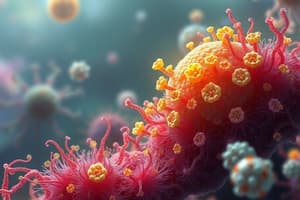Podcast
Questions and Answers
What characteristic do viruses lack that prevents them from being considered living organisms?
What characteristic do viruses lack that prevents them from being considered living organisms?
- Growth and development (correct)
- Genetic information
- Homeostasis (correct)
- Response to the environment
Which level of taxonomic classification immediately follows 'Domain'?
Which level of taxonomic classification immediately follows 'Domain'?
- Kingdom
- Supergroup (correct)
- Phylum
- Class
What does a clade represent in phylogenetic studies?
What does a clade represent in phylogenetic studies?
- A group excluding intermediate species
- A group without common ancestors
- A specialized form of a paraphyletic group
- A group including a common ancestor and all its descendants (correct)
Binomial nomenclature is used for what purpose in biological classification?
Binomial nomenclature is used for what purpose in biological classification?
Which of the following is true about phylogenetic trees?
Which of the following is true about phylogenetic trees?
What process describes when a single species evolves into two or more different species?
What process describes when a single species evolves into two or more different species?
Which type of taxonomic group includes a common ancestor but not all its descendants?
Which type of taxonomic group includes a common ancestor but not all its descendants?
Which of the following demonstrates homology among species?
Which of the following demonstrates homology among species?
What is the highest level in the hierarchical system of taxonomy?
What is the highest level in the hierarchical system of taxonomy?
Which of the following is a characteristic that distinguishes fungi from plants?
Which of the following is a characteristic that distinguishes fungi from plants?
Which group of protists is known for lacking true leaves, stems, and roots?
Which group of protists is known for lacking true leaves, stems, and roots?
What is the study of biological diversity and evolutionary relationships called?
What is the study of biological diversity and evolutionary relationships called?
Which of the following groups was fungi separated from in 1969?
Which of the following groups was fungi separated from in 1969?
What distinguishes eubacteria from archaebacteria?
What distinguishes eubacteria from archaebacteria?
What type of metabolism is characteristic of fungi?
What type of metabolism is characteristic of fungi?
Which of the following is not a domain of life?
Which of the following is not a domain of life?
Flashcards are hidden until you start studying
Study Notes
Taxonomy Overview
- Taxonomy involves the classification of living and extinct organisms based on evolutionary relationships.
- The hierarchical system of taxonomy has several levels, and each group within this system is called a taxon.
- The highest level is the domain, with all life classified into three domains: Bacteria, Archaea, and Eukarya.
Eukaryotic Subgroups
- The Eukarya domain further includes various subgroups such as:
- Excavata
- Land plants
- Alveolata
- Stramenopila
- Rhizaria
- Amoebozoa
- Large kingdoms within Eukarya include Plantae and Opisthokonta, which encompasses Fungi and Animalia.
Systematics
- Systematics studies biological diversity and the evolutionary links between both extinct and modern organisms.
- Fungi were classified as eukaryotic only in recent years, separated from Protista and Plantae in 1969 due to similarities in metabolism with animals (e.g., chitin cell wall, heterotrophy).
Unicellular Organisms
- Unicellular organisms are primarily bacteria (e.g., E. coli, streptococcus) and some protists (e.g., Amoeba, Euglena).
- All algae fall under the protist category, existing as both unicellular (e.g., Chlorella) and multicellular forms (e.g., seaweeds).
Multicellular Protists
- Multicellular protists are recognized as primary producers and are plant-like, lacking true leaves, stems, and roots.
- Types include:
- Brown algae (Phaeophyta)
- Red algae (Rhodophyta)
- Green algae (Chlorophyta)
Groups of Protists
- Protists can be categorized based on feeding mechanisms and locomotor abilities:
- Heterotrophs with no permanent locomotion
- Heterotrophs with limited movement
- Heterotrophs utilizing flagella
- Photosynthetic protists
Characteristics of Living Things
- Eight essential characteristics define living organisms:
- Composed of one or more cells
- Contain genetic material (DNA/RNA)
- Reproduce asexually
- Grow and develop
- Exchange energy and materials with the environment
- Maintain homeostasis
- Respond to stimuli
- Evolve as a species
- Viruses are not considered living as they only possess four of these characteristics.
Taxonomic Hierarchy
- The organized structure of life follows this chronological sequence:
- Domain
- Supergroup
- Kingdom
- Phylum
- Class
- Order
- Family
- Genus
- Species
- The relationship between taxonomic levels and the number of species is inversely proportional.
Binomial Nomenclature
- Naming organisms uses a two-part system (genus name + species epithet), indicated in italics or underlined, with the genus capitalized.
Phylogenetic Trees
- Phylogeny refers to the evolutionary history of species, depicted using phylogenetic trees, which hypothesize evolutionary relationships based on morphological and genetic data.
- They can illustrate how new species arise through:
- Anagenesis: evolution of a single species into different forms
- Cladogenesis: divergence of a species into multiple new species
Taxonomic Groupings
- Taxonomic groups can be:
- Monophyletic (clades): include a common ancestor and all its descendants
- Paraphyletic: include a common ancestor but not all descendants
- Polyphyletic: group species with different common ancestors
- Reorganization of taxonomic groups can occur as scientific understanding progresses.
Homology and Morphological Analysis
- Homology refers to similarities between species due to common ancestry, such as the structure of limbs in bats, humans, and cats.
- Morphological analysis examines these structures for systematic classification.
Studying That Suits You
Use AI to generate personalized quizzes and flashcards to suit your learning preferences.




